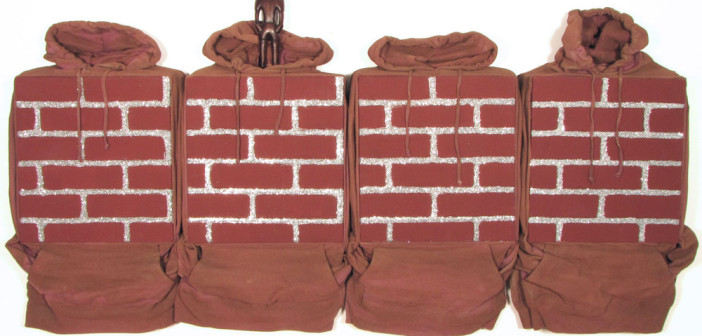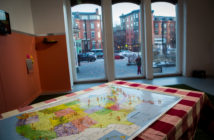The duo had one task: to feed each other a four course meal using these exaggerated utensils. They would stand up to eat, while the video behind them looped scenes from television shows - The Jeffersons, Good Times and The Cosby Show were all referenced throughout the performance. Between courses, the pair would reclaim their seats to stare eagerly at the screen, while the video moved at a much faster pace; advertisements, bits of news, and infomercials created a black and white mash-up of sounds and flashes, with distinct quotes like "ARE YOU PAYING YOUR BILLS ON TIME?" blaring out at the audience. One artist would feed the other, return their utensil neatly back into position, and wait for their partner to do same. Back and forth, this continued for a duration just shy of 35 minutes.
Adams, who in his artist talk described himself as an American artist making work that Americans can relate to, allowed me to view the performance with a certain bias. The expression "to feed with a long spoon" is one you would use about someone you are wary of trusting. Nourish your companion, but keep your distance.
Watching the video loop, I'm instantly reminded of certain scenes and tidbits of relevant pop culture I've come across myself over the past several weeks. For example, a ridiculous tweet by tweet replay of Miley Cyrus's decent into glam goth was broadcast live on CNN during prime time evening news. Presidential candidate Mitt Romney spoke to the American people about a mythical utopia, an "American America", citing "that good feeling when you have more time to volunteer to coach your kid’s soccer team, or help out on school trip" as the "strength, power, and goodness" of our country. Fun American facts? I recently discovered that Lady Gaga has 9 million more followers on twitter than Barack Obama, and read about how Apple Inc. has more cash than the U.S. Treasury.
What do we do when we come across certain instances in our culture that alarm us? Some of us retreat instantly to more personal thoughts, others might ignore or forget, but as the performers continued to stare adamantly at the screen, I was reminded that most of us would just keep watching the loop, curious and addicted.
It wasn't until the second dish, a salad course, that Adams's face cracked into a smile. The audience laughed as, struggling to pick up anything, he was only able to capture a single crouton; the woman, at this point, simply began catching the food with her hands as it fell from his fork. Things got more intense by the third course, a steak, which required utilizing both the fork and knife. Cooperation began to come into light, the pair teetered up and down in height to make it easier for their partner. The performers themselves struggled against impatience, their arms began to shake. While the woman's cut pieces of meat became increasingly larger at each turn, Adams's remained curiously smaller, as if he was fighting with himself not to simply stab the entire steak and feed it to her in one bite. The careful balance, their growing reliance on one another, and the increasing hilarity of their mission, made the dialogue between the artists much more amiable than its title presumed.
Ever-present, the overwhelming flow of contemporary media without a doubt grants us the independence to choose what we intake: if we don't like what we're watching, we can always change the channel. But while we have every option to select what we digest, we face an unavoidable (and often subliminal) lack of control over the source of the information - who filters it and edits it (who cooks, who serves) is unseen; while powerful, it remains an anonymous force impossible to track. The trick, it seems, is in how well we can feed each other - how well we communicate, guide one another through the viral abyss, and how quickly we can learn to trust in others. We must be willing (as Americans, or even as humans) to be patient, to refrain from chaos, and withstand our helplessness with the utmost respect for etiquette.
"The World According to Derrick: Performative Objects in Formation" is on view through 9/23 at The Mills Gallery, Boston Center for the Arts.
All images are courtesy of the artist and the Boston Center for the Arts.




